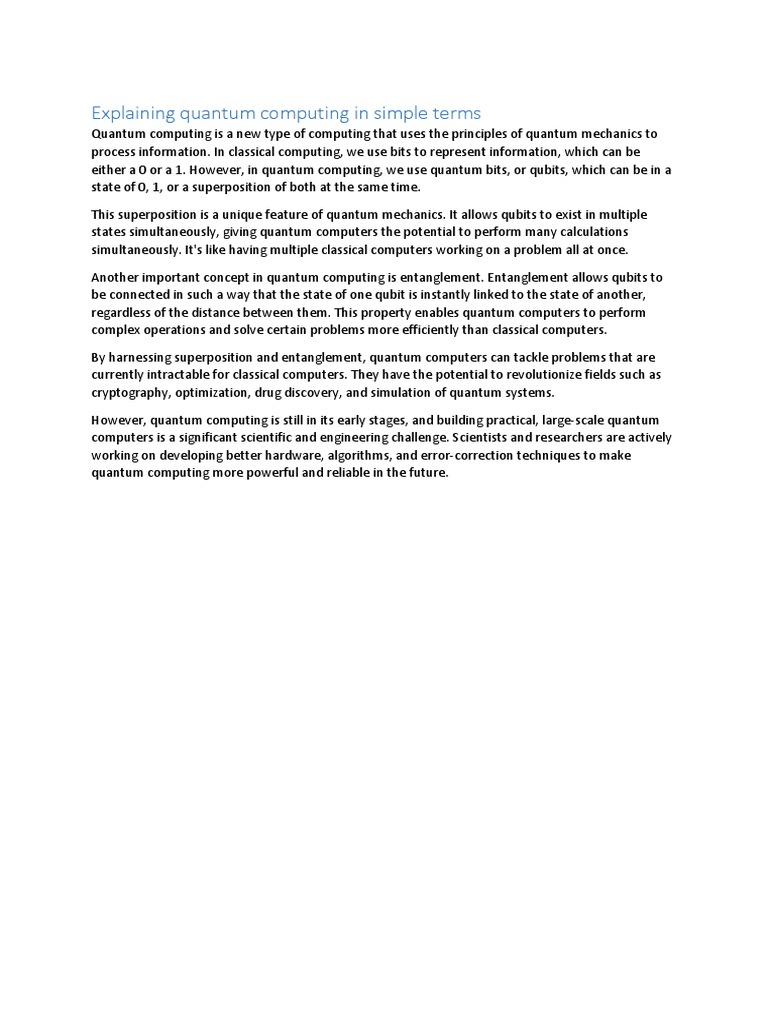Is there an easy way to explain Quantum Computing? At first glance, one might dismiss this inquiry as fanciful, cloaked in the veil of complexity often associated with physics. However, the challenge presents an intriguing paradox: how does one distill the esoteric intricacies of quantum mechanics into concepts accessible to the layperson? The landscape of quantum computing is laden with enigmas that often baffle even seasoned experts. Yet, it is within this very perplexity that an opportunity emerges to foster comprehension.
To embark upon this exploration, it is imperative first to delineate the rudimentary principles that govern classical computing. Classical computers function through the manipulation of bits, the most fundamental units of information, which exist as binary digits—either 0 or 1. This binary framework allows for deterministic operations, wherein the states of bits flow seamlessly through logic gates, performing calculations with precision. Yet, the realm of quantum computing introduces a revolutionary paradigm shift, rooted in the principles of quantum mechanics.
Imagine, if you will, a dance of particles, where uncertainty reigns supreme. In quantum computing, the basic unit of information transforms into a quantum bit, or qubit, which can concurrently embody multiple states—even existing in a superposition of 0 and 1. This contrasts sharply with classical bits, which must exist distinctly as one state or the other. The visualization of qubits as spinning coins illustrates this concept aptly: until observed, a spinning coin remains in a superposition, displaying the potentiality of both sides.
However, engaging with superposition raises additional questions. If a qubit can represent multiple states simultaneously, how does this translate into computational power? The answer lies in the phenomenon of entanglement—a cornerstone of quantum theory. When qubits become entangled, the state of one qubit instantaneously influences the state of another, regardless of the distance separating them. This peculiar link offers a profound advantage, enabling quantum computers to perform complex calculations at unprecedented speeds.
Yet, herein lies an intriguing conundrum: the more we delve into the workings of quantum computing, the more complex the explanations become. How can one simplify these concepts without sacrificing their depth? A practical analogy emerges from the realm of everyday experiences: consider the process of searching for a name in a directory. A classical computer resembles a diligent librarian who examines the directory linearly, one entry at a time. In contrast, a quantum computer behaves more like a magical assistant, who instantaneously scans all entries, pinpointing the name without the exhaustive labor—a true marvel of efficiency.
To further consolidate this understanding, it is worthwhile to elucidate the practical applications of quantum computing. These applications span multiple domains, ranging from cryptography to drug discovery. In cryptography, quantum computers hold the potential to unravel complex encryption algorithms, presenting both opportunities and challenges. On the one hand, quantum encryption techniques, such as quantum key distribution, could lead to secure communication channels immune to interception. Conversely, the advent of quantum computing casts shadows over existing security protocols, necessitating a reevaluation of data protection methods.
In the realm of pharmaceuticals, quantum computing promises to revolutionize drug discovery processes. The intricate molecular interactions and complex chemical reactions, which typically require extensive computational resources, can be simulated with unparalleled precision using quantum algorithms. This capacity for modeling allows researchers to investigate potential drug candidates and accelerate their development in ways previously deemed unfeasible.
Despite the tantalizing prospects, the journey towards practical quantum computing is fraught with challenges. Building a quantum computer is an engineering feat burdened with hurdles that have yet to be fully surmounted. Qubits are notoriously fragile, vulnerable to decoherence—a phenomenon where quantum states lose their coherence due to environmental interference. Moreover, the requirement for extreme conditions, such as near absolute zero temperatures, complicates the scalability of quantum systems.
As the conversation surrounding quantum computing continues to evolve, it remains imperative to engage diverse audiences in a thoughtful dialogue. Distilling complex concepts into digestible morsels is an ongoing challenge, yet it serves as a catalyst for broader understanding. Educators and practitioners are urged to embrace metaphors, visuals, and interactive experiences that resonate with the imagination, bridging the chasm between abstraction and reality.
In conclusion, the quest to explain quantum computing in simple terms invites participants into a labyrinth of intellectual curiosity. The interplay of superposition and entanglement provokes thought, while the practical applications illuminate its potential impact on society. The challenge lies not only in clarification but also in fostering a culture of inquiry that encourages exploration, experimentation, and a humble acceptance of our current knowledge gaps. It is within this cultural framework that the beauty of quantum computing may be fully appreciated, paving the way for future innovations that transcend our wildest imaginations.










